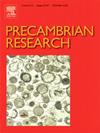Spatio-temporal tectonic progression in the Dharwar Craton: Insights from volcanic records of Archean greenstone belts
IF 3.2
2区 地球科学
Q2 GEOSCIENCES, MULTIDISCIPLINARY
引用次数: 0
Abstract
Volcanic episodes serve as precursors for the formation and evolution of continental crust and directly impact the mantle compositions. Here, we present elemental, zircon U-Pb and Sm-Nd isotopic datasets of published and newly generated data on the Archean volcanic sequences from the Dharwar Craton and constrain the thermal and chemical evolution of the Archean mantle, continental growth, geodynamic evolution and craton formation. The data reveal three phases of ultramafic volcanism at 3.4–3.25 Ga, 3.2–3.05 Ga and 2.7–2.6 Ga; two major phases of mafic volcanic activity at 3.35–3.15 Ga and 2.75–2.5 Ga, and three felsic volcanic episodes at 3.4–3.2 Ga, 2.9–2.7 Ga and 2.65–2.5 Ga, which are associated with granitoid formation at ca. 3.4–3.25 Ga, 3.1–3.0 Ga, 2.7–2.6 Ga and 2.56–2.54 Ga. The εNd(t) values of +2 to +6 and εHf(t) values of −5 to ∼10 of these suites depict heterogeneous mantle reservoirs. These temporal isotopic variations are further constrained spatially through elemental ratios, which suggest the origin of ultramafic melts from deeper, primitive to highly depleted mantle reservoirs, with traces of crustal contamination.
The origin of the Paleo- to Neoarchean (3.4–2.54 Ga) volcanism in the Dharwar Craton is explained through the evolving tectonics in the early Earth, where mantle plume activity initiated ultramafic volcanism. A decrease in temperature and pressure, an increase in the degree of partial melting, and a compositional change in the komatiites are consequences of the thermal evolution of the mantle within the Paleoarchean to Neoarchean timeframe. Among the arc basalts, the first two phases that are the melt products of enriched mantle, reflect the subduction of oceanic plateau-type proto-crust. The third phase, representing enriched to depleted mantle sources, supports the existence of an array of oceanic to continental arcs. The three phases can be correlated with tectonic stages involving predominant plume-subordinate arc (Stage I), subordinate plume-predominant arc (Stage II) and prevalent arc (Stage III) volcanism, followed by the accretion of arcs and craton formation spanning the Paleo- and Neoarchean timeframe. These studies reveal that the Dharwar Craton has formed through successive stages of greenstone volcanism and plutonism in a transient tectonic environment.

达瓦尔克拉通时空构造演化:来自太古宙绿岩带火山记录的启示
火山期是大陆地壳形成和演化的前兆,直接影响着地幔的组成。本文利用已发表的和新生成的太古宙火山序列的元素、锆石U-Pb和Sm-Nd同位素数据集,对太古宙地幔的热化学演化、大陆生长、地球动力学演化和克拉通形成进行了约束。资料显示,在3.4 ~ 3.25 Ga、3.2 ~ 3.05 Ga和2.7 ~ 2.6 Ga存在3期超镁铁性火山活动;3.35 ~ 3.15 Ga和2.75 ~ 2.5 Ga两个主要的基性火山活动期,以及3.4 ~ 3.2 Ga、2.9 ~ 2.7 Ga和2.65 ~ 2.5 Ga三个长英质火山活动期,它们与约3.4 ~ 3.25 Ga、3.1 ~ 3.0 Ga、2.7 ~ 2.6 Ga和2.56 ~ 2.54 Ga花岗岩的形成有关。这些套的εNd(t)值为+2 ~ +6,εHf(t)值为- 5 ~ ~ 10,描述了非均质幔储层。这些时间同位素变化通过元素比率进一步限制了空间上的变化,这表明超镁铁质熔体来自更深的原始地幔储层到高度枯竭的地幔储层,并带有地壳污染的痕迹。通过地球早期构造演化,解释了达瓦尔克拉通古-新太古代(3.4-2.54 Ga)火山活动的起源,地幔柱活动引发了超基性火山活动。古太古代至新太古代期间地幔热演化的结果是温度和压力的降低、部分熔融程度的增加和科马长岩成分的变化。在弧玄武岩中,前两期为富集地幔的熔融产物,反映了大洋高原型原地壳的俯冲。第三阶段,代表了丰富到枯竭的地幔源,支持了一系列海洋到大陆弧的存在。这三个阶段可以与古太古代和新太古代的构造阶段相关联,包括主导羽状-从属弧状(第1阶段)、从属羽状-主导弧状(第2阶段)和主导弧状(第3阶段)火山作用,以及随后的弧状增生和克拉通形成。这些研究表明,达瓦尔克拉通是在过渡性构造环境中经历了绿岩火山作用和深部作用的连续阶段而形成的。
本文章由计算机程序翻译,如有差异,请以英文原文为准。
求助全文
约1分钟内获得全文
求助全文
来源期刊

Precambrian Research
地学-地球科学综合
CiteScore
7.20
自引率
28.90%
发文量
325
审稿时长
12 months
期刊介绍:
Precambrian Research publishes studies on all aspects of the early stages of the composition, structure and evolution of the Earth and its planetary neighbours. With a focus on process-oriented and comparative studies, it covers, but is not restricted to, subjects such as:
(1) Chemical, biological, biochemical and cosmochemical evolution; the origin of life; the evolution of the oceans and atmosphere; the early fossil record; palaeobiology;
(2) Geochronology and isotope and elemental geochemistry;
(3) Precambrian mineral deposits;
(4) Geophysical aspects of the early Earth and Precambrian terrains;
(5) Nature, formation and evolution of the Precambrian lithosphere and mantle including magmatic, depositional, metamorphic and tectonic processes.
In addition, the editors particularly welcome integrated process-oriented studies that involve a combination of the above fields and comparative studies that demonstrate the effect of Precambrian evolution on Phanerozoic earth system processes.
Regional and localised studies of Precambrian phenomena are considered appropriate only when the detail and quality allow illustration of a wider process, or when significant gaps in basic knowledge of a particular area can be filled.
 求助内容:
求助内容: 应助结果提醒方式:
应助结果提醒方式:


